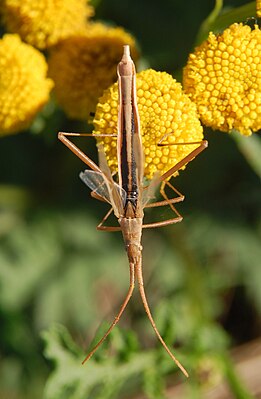Chorosoma schillingii
| Chorosoma schillingii | ||||||||||||
|---|---|---|---|---|---|---|---|---|---|---|---|---|

Chorosoma schillingii |
||||||||||||
| Systematics | ||||||||||||
|
||||||||||||
| Scientific name | ||||||||||||
| Chorosoma schillingii | ||||||||||||
| ( Schilling , 1829) |
Chorosoma schillingii is a bug from the family of glass wing bugs (Rhopalidae). The species is unmistakable in northern Central Europe due to its unusual build.
features
The body of Chorosoma schillingii is very narrow and long, especially males are almost rod-shaped. The antennae and legs are also noticeably long. The animals have a body length of 14.0 to 16.0 mm. The first antenna segment is as long or longer than the head. The pronotum shows a clear central keel. The species is always long-winged ( macropter ), but the corium only extends to the rear edge of the fourth tergite . As with all species of the Chorosomini tribe , the anal cone often protrudes from the opening of the 7th tergite and is then visible from above. The body is light yellow-brown.
distribution and habitat
The distribution area extends from the British Isles and North Africa over almost all of Europe and Asia Minor to Central Asia . Chorosoma schillingii is absent in Europe in the north of the British Isles and in large parts of Scandinavia . The species needs warmth and is therefore not found in the higher elevations of the low mountain ranges in Germany and in the Alps; in Austria it is restricted to the east of the country. It is occasionally common in the north German lowlands.
Chorosoma schillingii colonizes dry and warm open habitats, especially on sandy soils, and inhabits the herb layer here .
Way of life
Like all glass winged bugs, Chorosoma schillingii is phytophagous and feeds on the leaves, stems and immature seeds of their host plants. It was found on various sweet grasses (Poaceae), but after the seeds ripen it probably also sucks on other plants, e.g. B. Dock ( Rumex spp.). The species overwinters as an egg. Nymphs can be observed from May, adults from late June to September. Mating was mostly documented in July and August. The eggs are laid from August, with the eggs being laid individually on blades of grass. In Central Europe only one generation is educated, in the Mediterranean and Eastern Europe there can be two.
swell
literature
- Zoological State Collection Munich: Identification key of the family Rhopalidae AMYOT & SERVILLE, 1843, subfamily Rhopalinae AMYOT & SERVILLE, 1843 (glass wing bugs) from Bavaria. ( Full text online as PDF ).
- Ekkehard Wachmann , Albert Melber, Jürgen Deckert: Bugs. Volume 3: Aradidae, Lygaeidae, Piesmatidae, Berytidae, Pyrrhocoridae, Alydidae, Coreidae, Rhopalidae, Stenocephalidae. Goecke & Evers, Keltern 2007, ISBN 978-3-937783-29-1 , pp. 249-251.
Web links
- Chorosoma schillingii in Fauna Europaea. Retrieved September 15, 2011
